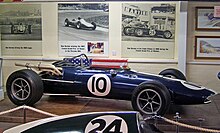AAR Eagle
| Surname | eagle |
|---|---|
| Companies | |
| Company headquarters | United States |
| Team boss | Dunne, Dan Gurney |
| statistics | |
| First Grand Prix | Belgium 1966 |
| Last Grand Prix | Canada 1969 |
| Race driven | 26th |
| Constructors' championship | 0 |
| Drivers World Championship | 0 |
| Race wins | 1 |
| Pole positions | 0 |
| Fastest laps | 2 |
| Points | 17th |
AAR Eagle refers to racing cars from the 1960s to 1990s that were built by the team of Californian Dan Gurney . The abbreviation AAR initially stood for the company All American Racers , founded by Gurney together with the former US racing driver Carroll Shelby , in which Shelby worked in the USA from 1965 to 1970. Under the leadership of Gurney, who was previously successful as a Grand Prix driver, a parallel company was set up in Rye (Sussex), England, under the name Anglo American Racers , in order to be present in the European racing series. The cars should go to the start under the designation Eagle (eagle, the heraldic animal of the USA).
Tire maker Goodyear acted as a sponsor with the intention of breaking Firestone's longstanding dominance as a tire supplier for the Indianapolis 500 .
In the USA
At the end of the 1960s, the team began to celebrate their first major successes in the USA. In 1968, Bobby Unser won the Indianapolis 500 and the series, opening the door to American motorsport for Goodyear. By 1986, Eagle had delivered two more Indy500 victories, and vehicles for the US monoposto series. Then Gurney initially turned away from the single-seaters and became a partner of Toyota in order to prepare and accompany their appearance in the sports car scene. After the 1999 CART season, the construction of single-seaters was finally given up.
Eagle in Formula 1
The first design for an Eagle Formula 1 car came from Len Terry . The vehicle was designed so that it could be used in Formula 1 as well as - with adaptations - in the USAC series. Terry followed the Lotus 38 for the lines . The car, which was called the Eagle T1G , had a light metal monocoque and a suspension with double wishbones . Gurney ordered a V-12 engine from the engine manufacturer Weslake and bridged the time until completion with 2.75-liter Climax engines. These were already discontinued models, so the vehicle was underpowered at the beginning. Nevertheless, it was enough to win the first World Championship points at the 1966 French Grand Prix when Gurney finished fifth.
The Weslake 3 liter engine with four overhead camshafts was more successful. It was first used in Monza in 1966 at the Italian Grand Prix . The gear problems that arose in Monza for the first time could not be completely resolved later. The engine had enough power, however, production was never geared towards series production and all engines remained unique. The team always had to struggle with the different engine power of the engines and the parts could hardly be exchanged from engine to engine. The problems were only solved when Gurney took over engine construction and maintenance in his own factory.
The big day for the team was the 1967 Belgian Grand Prix , just a week after Gurney's Le Mans win. Gurney won the first and only world championship run for the team with the Eagle-Weslake.
As the activities shifted more and more to the USA, the involvement in Formula 1 decreased noticeably. The 1968 season was contested with a slightly improved version of the T1G without much success. In the meantime, the freely available Ford Cosworth V8 has become the standard engine in F1, and many teams have built their own cars. In 1969 Tony Southgate was working on a new vehicle, but it was never finished. The last Grand Prix for an Eagle was the 1969 Canadian Grand Prix , the two subsequent races in North America were skipped, Eagle withdrew completely from Formula 1 and concentrated on the USA.
Eagle in North American series
Gurney's Eagles won the Indy 500 with Bobby Unser in 1968 and 1975, with Gordon Johncock in 1973. Dan Gurney developed the Gurney Flap during test drives with his Indycar team in 1971 , a spoiler lip on the rear wing that increases downforce. A total of 51 Champcar races were won until they finally withdrew from the single-seaters after the 1999 CART season. In 1968 and 1969 the team won the US Formula 5000 championship with the Eagle Mk5 .
Between 1987 and 1995 Gurney used sports cars in the IMSA series in collaboration with Toyota .
Literature and Sources
- David Hodges: Racing Cars from A to Z after 1945 Motorbuch Verlag, Stuttgart 1994, p. 81, ISBN 3-613-01477-7 .

